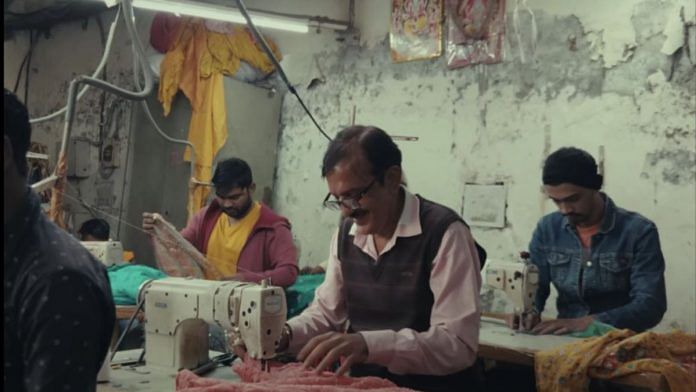New Delhi: Once the driver of commercial success in Hindi cinema, especially in the 1970s and 1980s, the working-class hero has all but disappeared from popular imagination and films. But a new short film, Jal Tu Jalaal Tu, directed by Prateek Vats, takes a long, hard look at the plight of workers through the story of a senior tailor at a cloth factory.
“When you want to make a movie on the economically marginalised, which are not aspirational stories with a ‘hero’ figure, capital is hard to raise. It is not a pretty sight to watch how we treat labourers in this country,” said Vats.
The 29-minute film was inspired by Anton Chekhov’s’ 1883 short story, The Death of a Government Clerk.
Commissioned by the Mumbai Academy of Moving Image (MAMI) Select, this film is one of the five independent projects created under its ‘Shot on iPhone’ category. Other titles include Mirage, Obur, Crossing Borders and A New Life, which have all been released on MAMI’s YouTube channel on 19 April.
Vats, who earlier directed the critically acclaimed Eeb Allay Ooo! (2019), teamed up with his long-time collaborator and scriptwriter Shubham for Jal Tu Jalal Tu. Shubham also made his directorial debut with the film, which credits him as co-director.
Along with scriptwriter Shubham, Vats has been trying to make films on the anxiety-ridden world of labourers, characterised by instability and irregular income.
In Jal Tu Jalaal Tu, senior tailor Madan (Harsh Khanna) and his co-workers in a North Indian town’s unnamed garment factory race against time to complete an order for their boss (Abhishek Annica). When Madan and others share a moment of laughter amid the stress, their supervisor (Himanshu Kohli) admonishes them. This incident soon begins to unravel the factory’s complicated power dynamics – and Madan’s life.
Shubham and Vats always wanted to make a film on Chekhhov’s story, but nothing worked out until MAMI selected five directors to make a short film on their iPhones. They revisited their old idea, and the first thing they did was zero in on the location–a friend’s father-in-law’s cloth factory in Sonipat, Haryana. Finalising the location helped Shubham finally get on with the screenplay, and focus on the lives of workers in the factory.
“Peasants sneeze and so do police superintendents, and sometimes even privy councillors. All men sneeze,” Chekhov had written in his book. And Shubham and Vats played around with it in Jal Tu Jalaal Tu.
Except laughter is often a sign of irreverence, and those who are marginalised aren’t allowed the luxury of it. Madan knows it and tries to apologise, reading and analysing the behaviour and body language of his superior as retribution for his laughter.
A glimpse into the worker’s world
Eeb Allay Oo was the first collaboration between Vats and Shubham. It tells the story of a young migrant, Anjani Prasad, who takes on the government job of keeping monkeys away from public buildings in New Delhi. The onomatopoeic title comes from the three distinct sounds used by an older monkey chaser in the movie, which was later released on Netflix. It was also a full-length feature film, unlike Jal Tu Jalaal Tu.
“Our concern was that shooting on the phone should not make the topic or treatment look too frivolous,” said Shubham.
The duo was mentored by Bollywood filmmaker Vishal Bhardwaj, whose Fursat (2019), too, was shot on an iPhone. Jal Tu Jalal Tu is part of a popular Hindi prayer that invokes God in times of crisis. In the film, the crisis is brought upon by Madan’s interpretation of his boss’ apparent hostility toward his laughter.
The desperation to keep their jobs ties together Eeb Allay Oo’s Anjani and Jal Tu Jalal Tu’s Madan. Anjani wears langur costumes and uses recorded sounds to keep his monkey chaser job, whereas Madan repeatedly apologises to his stubborn boss.
Also read:
Reversing stereotypes
Shubham and Vats employ different techniques to provide unique, distinctive insights into the world of workers. In Jal Tu Jalal Tu, they choose to give proper names only to Madan, the central character, and his teammates. In contrast, the higher-ups in the factory are simply identified by their roles (supervisor, boss). This approach reverses the customary representation of labourers, bringing their personalities and identities to the forefront.
“Whenever we tell the story of a worker, we see him under pressure or overworked. I wondered what the new way of showing a worker was, and thought of laughter. We tend to forget workers are humans, and they can laugh too,” said Shubham.
There was a time when Bollywood teemed with class ‘heroes’— a trope especially popularised by Amitabh Bachchan. Movies like Namak Haram (1973), Deewar (1973) and Coolie (1983) are still popular favourites. There was also BR Chopra’s Mazdoor (1983), which starred Dilip Kumar. These films, however, ended up focusing on the ‘heroics’ of the working-class protagonist rather than their world.
But as aspirations changed over time, the working-class hero disappeared from the big screen.
“When we talk of marginalised classes, we imagine them as perfect. We turn them into objects because we are robbing them of the dignity of making mistakes and being imperfect,” said Shubham. Vats and him want to change this, one movie at a time.
(Edited by Zoya Bhatti)



